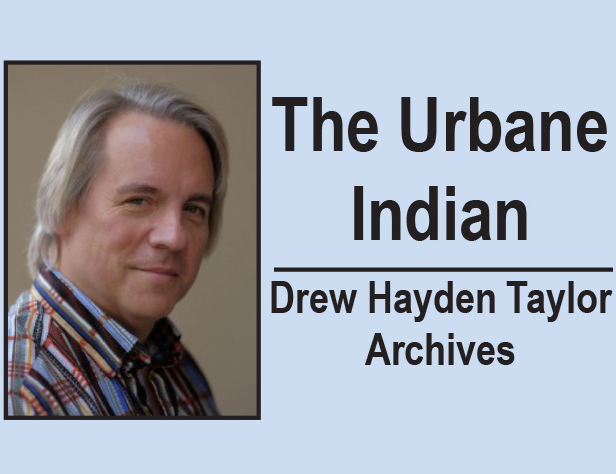
By Drew Hayden Taylor
Originally posted in March 2011
It’s been said that politics makes strange bedfellows. Well, whoever said that has obviously not worked in Native theatre.
I say this because Native theatre is an odd mistress indeed. You work with interesting people with interesting talents. You find yourself doing and saying things you wouldn’t normally say or do. And it all seems so … normal.
It’s in this unique vortex called Native theatre that art and culture are synthesized into a unique and often bizarre hybrid. I often wonder if other theatre companies end up doing or even saying some of the things we do. Or deal with the unique taboos that occasionally pop up.
I bring this all up because this coming year is going to be a busy theatre year for yours truly and it will be interesting to see what adventures may arise from it. You see, in February, my play In A World Created By A Drunken God is going to be produced at Theatre Orangeville and possibly in Calgary next fall (negotiations are ongoing). In June, The Berlin Blues opens at 4th Line Theatre in Peterborough. I also have a couple of children’s plays currently touring the country too.
One time several years ago when I was doing quite a bit of work with the Saskatchewan Native Theatre Company (SNTC) in Saskatoon, they came up with a unique way of raising money for the company. They had their own black box (a small, intimate, square shaped theatre, as the name implies) and they thought it would be interesting and fun to culturally appropriate a popular English film for a fundraising cabaret.
The film – The Full Monty. The Cabaret – The Full Bannock. For those not fully knowledgeable about Aboriginal cuisine, bannock is a type of Indian fried bread; Golden brown, tasty, and hot, just like a lot of Native actors, I suppose. And playwrights, of course.
So they were looking for a small (don’t take that the wrong way) line up of Native men to perform the required choreographed scene on stage for a paying audience. Men with a recognizable name and hopefully an appeal that would encourage patrons (one would think female ones) with disposable income to attend. They had one position left in the chorus line to fill. So they asked me.
Normally, I don’t dance or sing, clothed or unclothed, but here I was in a bit of a situation. I was flattered by the attention, and their interest in me parading my stuff. I had great respect and admiration for SNTC and the work they did. I would do anything I could to support them. But perhaps this was a little above and beyond the call of duty.
At first I thought my girlfriend might come to my rescue and object to the very thought of me showing off the bannock in such a public display. Nope. She thought it was a fabulous idea and gave me her full, if amused, endorsement. Yet I knew my best naked days were way behind me – so to speak.
To make a long story short, the fundraiser never happened, and I was saved any public embarrassment, though occasionally they still threaten to revisit the idea. I wonder if they would have used that song from 1950s, ‘Running Bear,’ as the actual number? Or that Rolling Stones song, ‘Brown Sugar.’ Or possibly that old novelty country song, ‘Don’t Go Near The Indians.’
I have to safely say, I have never been asked to take my clothes off for any mainstream, or non-Native theatre company. I hope Theatre Orangeville or 4th Line Theatre doesn’t get any ideas.
That wasn’t the only unusual case where combining culture and craft created a conflict for me. I was once working with a Cree director on a play, and at one point he couldn’t help admiring my shirt.
“That’s a very nice shirt you’re wearing,” he told me. I, of course, thanked him. Then he paused for a moment before adding “you know, in the Cree community, when somebody compliments you on something they like, its traditional to give it to them. Yep, that’s a really nice shirt.”
Though I was Ojibway, not Cree, I still couldn’t help feeling that my respect and Aboriginalism was being called into question. So, feeling pressured, I started unbuttoning my shirt to give it to him, like a good Indigenous person would. As I undid the last button, I casually mentioned to him, “By the way Floyd, I really like your girlfriend.”
Briefly put, I got to keep my shirt, but I was more than willing to give him the very shirt off my back in the name of traditionalism. I guess maybe I was a little more traditional than he was.
